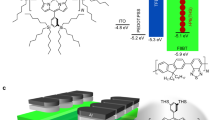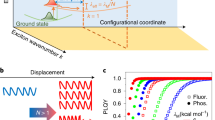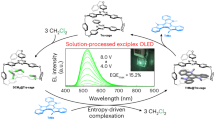Abstract
The emission of light by polyatomic molecules in the spectral region of the second near-infrared (NIR(II)) window is severely hampered by the energy gap law, namely the quenching induced by exciton–vibration coupling. As a result, organic light-emitting diodes (OLEDs) with efficient emission wavelengths of ~1,000 nm and above are rare, despite their potential for phototherapy and bioimaging. In this study we revisit the theory of the energy gap law to quantify the contribution of each coupled vibrational mode to non-radiative transitions. The results lead us to propose two approaches that favour emission: molecular packing to extend exciton delocalization, and deuterium substitution to reduce high-frequency vibrations. We provide an experimental proof of concept by designing and synthesizing a new series of self-assembled Pt(II) complexes that exhibit high-intensity phosphorescence with peak quantum yields of (23 ± 0.3)% at approximately 1,000 nm. The corresponding OLEDs emit at a peak wavelength of 995 nm with a maximum external quantum efficiency of 4.31% and a radiance of 1.55 W sr−1 m−2, marking a substantial contribution to the development of efficient OLEDs in the NIR(II) region.
This is a preview of subscription content, access via your institution
Access options
Access Nature and 54 other Nature Portfolio journals
Get Nature+, our best-value online-access subscription
$29.99 / 30 days
cancel any time
Subscribe to this journal
Receive 12 print issues and online access
$209.00 per year
only $17.42 per issue
Buy this article
- Purchase on Springer Link
- Instant access to full article PDF
Prices may be subject to local taxes which are calculated during checkout





Similar content being viewed by others
Data availability
The data that support the plots and other findings within this paper are available from the corresponding author upon reasonable request.
References
Khan, Y. et al. A flexible organic reflectance oximeter array. Proc. Natl Acad. Sci. USA 115, E11015–E11024 (2018).
Han, D. et al. Pulse oximetry using organic optoelectronics under ambient light. Adv. Mater. Technol. 5, 1901122 (2020).
Lei, Z. & Zhang, F. Molecular engineering of NIR‐II fluorophores for improved biomedical detection. Angew. Chem. Int. Ed. 60, 16294–16308 (2021).
Simone, G. et al. High‐accuracy photoplethysmography array using near‐infrared organic photodiodes with ultralow dark current. Adv. Opt. Mater. 8, 1901989 (2020).
Jeon, Y. et al. Sandwich-structure transferable free-form OLEDs for wearable and disposable skin wound photomedicine. Light Sci. Appl. 8, 114 (2019).
Zhang, L. et al. Infrared skin‐like active stretchable electronics based on organic–inorganic composite structures for promotion of cutaneous wound healing. Adv. Mater. Technol. 4, 1900150 (2019).
Englman, R. & Jortner, J. The energy gap law for radiationless transitions in large molecules. Mol. Phys. 18, 145–164 (1970).
Tuong, Ly,K. et al. Near-infrared organic light-emitting diodes with very high external quantum efficiency and radiance. Nat. Photonics 11, 63–68 (2017).
Chen, W. C. et al. Modulation of solid‐state aggregation of square‐planar Pt(II) based emitters: enabling highly efficient deep‐red/near infrared electroluminescence. Adv. Funct. Mater. 30, 2002494 (2020).
Wang, S. F. et al. Highly efficient near‐infrared electroluminescence up to 800 nm using platinum(II) phosphors. Adv. Funct. Mater. 30, 2002173 (2020).
Wei, Y.-C. et al. Overcoming the energy gap law in near-infrared OLEDs by exciton–vibration decoupling. Nat. Photonics 14, 570–577 (2020).
Kim, K.-H. et al. Crystal organic light-emitting diodes with perfectly oriented non-doped Pt-based emitting layer. Adv. Mater. 28, 2526–2532 (2016).
Liang, Q. et al. Near-infrared-II thermally activated delayed fluorescence organic light-emitting diodes. Chem. Commun. 56, 8988–8991 (2020).
Antaris, A. L. et al. A small-molecule dye for NIR-II imaging. Nat. Mater. 15, 235–242 (2016).
Hu, Z. et al. First-in-human liver-tumour surgery guided by multispectral fluorescence imaging in the visible and near-infrared-I/II windows. Nat. Biomed. Eng. 4, 259–271 (2020).
Hong, G. et al. Ultrafast fluorescence imaging in vivo with conjugated polymer fluorophores in the second near-infrared window. Nat. Commun. 5, 4206 (2014).
Zhong, Y. & Dai, H. A mini-review on rare-earth down-conversion nanoparticles for NIR-II imaging of biological systems. Nano Res. 13, 1281–1294 (2020).
Smith, A. M., Mancini, M. C. & Nie, S. Second window for in vivo imaging. Nat. Nanotechnol. 4, 710–711 (2009).
Vasilopoulou, M. et al. Advances in solution-processed near-infrared light-emitting diodes. Nat. Photonics 15, 656–669 (2021).
Lin, S. H. Rate of interconversion of electronic and vibrational energy. J. Chem. Phys. 44, 3759–3767 (1966).
Chang, S.-Y. et al. Platinum(II) complexes with pyridyl azolate-based chelates: synthesis, structural characterization, and tuning of photo- and electrophosphorescence. Inorg. Chem. 45, 137–146 (2006).
Su, B.-K. et al. The observation of interchain motion in self-assembled crystalline platinum(II) complexes: an exquisite case but by no means the only one in molecular solids. J. Phys. Chem. Lett. 12, 7482–7489 (2021).
Köhler, A. et al. The role of C–H and C–C stretching modes in the intrinsic non-radiative decay of triplet states in a Pt-containing conjugated phenylene ethynylene. J. Chem. Phys. 136, 094905 (2012).
Caspar, J. V., Kober, E. M., Sullivan, B. P. & Meyer, T. J. Application of the energy gap law to the decay of charge-transfer excited states. J. Am. Chem. Soc. 104, 630–632 (1982).
Thompson, D. G., Schoonover, J. R., Timpson, C. J. & Meyer, T. J. Time-dependent Raman analysis of metal-to-ligand charge transfer excited states: application to radiative and nonradiative Decay. J. Phys. Chem. A 107, 10250–10260 (2003).
Cummings, S. D. & Eisenberg, R. Tuning the excited-state properties of platinum(II) diimine dithiolate complexes. J. Am. Chem. Soc. 118, 1949–1960 (1996).
Kober, E. M., Caspar, J. V., Lumpkin, R. S. & Meyer, T. J. Application of the energy gap law to excited-state decay of osmium(II)–polypyridine complexes: calculation of relative nonradiative decay rates from emission spectral profiles. J. Phys. Chem. 90, 3722–3734 (1986).
Glusac, K., Köse, M. E., Jiang, H. & Schanze, K. S. Triplet excited state in platinum–acetylide oligomers: triplet localization and effects of conformation. J. Phys. Chem. B 111, 929–940 (2007).
Chesnut, D. B. & Suna, A. Fermion behavior of one‐dimensional excitons. J. Chem. Phys. 39, 146–149 (1963).
Van Burgel, M., Wiersma, D. A. & Duppen, K. The dynamics of one‐dimensional excitons in liquids. J. Chem. Phys. 102, 20–33 (1995).
Sun, L. et al. Bright infrared quantum-dot light-emitting diodes through inter-dot spacing control. Nat. Nanotechnol. 7, 369–373 (2012).
Pradhan, S. et al. High-efficiency colloidal quantum dot infrared light-emitting diodes via engineering at the supra-nanocrystalline level. Nat. Nanotechnol. 14, 72–79 (2019).
Pradhan, S., Dalmases, M., Baspinar, A. B. & Konstantatos, G. Highly efficient, bright, and stable colloidal quantum dot short‐wave infrared light‐emitting diodes. Adv. Funct. Mater. 30, 2004445 (2020).
Tong, C. C. & Hwang, K. C. Enhancement of OLED efficiencies and high-voltage stabilities of light-emitting materials by deuteration. J. Phys. Chem. C 111, 3490–3494 (2007).
Li, W. et al. Improved efficiency and stability of red phosphorescent organic light-emitting diodes via selective deuteration. J. Phys. Chem. Lett. 13, 1494–1499 (2022).
Tsuji, H. & Nakamura, E. Design and functions of semiconducting fused polycyclic furans for optoelectronic applications. Acc. Chem. Res. 50, 396–406 (2017).
Bae, H. J. et al. Protecting benzylic C–H bonds by deuteration doubles the operational lifetime of deep‐blue Ir‐phenylimidazole dopants in phosphorescent OLEDs. Adv. Opt. Mater. 9, 2100630 (2021).
Tsuji, H., Mitsui, C. & Nakamura, E. The hydrogen/deuterium isotope effect of the host material on the lifetime of organic light-emitting diodes. Chem. Commun. 50, 14870–14872 (2014).
Qian, G. et al. Simple and efficient near-infrared organic chromophores for light-emitting diodes with single electroluminescent emission above 1000 nm. Adv. Mater. 21, 111–116 (2009).
Tessler, N., Medvedev, V., Kazes, M., Kan, S. & Banin, U. Efficient near-infrared polymer nanocrystal light-emitting diodes. Science 295, 1506–1508 (2002).
Graham, K. R. et al. Extended conjugation platinum(II) porphyrins for use in near-infrared emitting organic light emitting diodes. Chem. Mater. 23, 5305–5312 (2011).
Nagata, R., Nakanotani, H. & Adachi, C. Near‐infrared electrophosphorescence up to 1.1 µm using a thermally activated delayed fluorescence molecule as triplet sensitizer. Adv. Mater. 29, 1604265 (2017).
Congrave, D. G. et al. A simple molecular design strategy for delayed fluorescence toward 1000 nm. J. Am. Chem. Soc. 141, 18390–18394 (2019).
Murto, P. et al. Triazolobenzothiadiazole-based copolymers for polymer light-emitting diodes: pure near-infrared emission via optimized energy and charge transfer. Adv. Opt. Mater. 4, 2068–2076 (2016).
Tregnago, G., Steckler, T. T., Fenwick, O., Andersson, M. R. & Cacialli, F. Thia- and selena-diazole containing polymers for near-infrared light-emitting diodes. J. Mater. Chem. C 3, 2792–2797 (2015).
Chen, M. et al. 1 micron wavelength photo- and electroluminescence from a conjugated polymer. Appl. Phys. Lett. 84, 3570–3572 (2004).
Acknowledgements
We are grateful to the National Center for High-performance Computing (NCHC) of Taiwan for the valuable computer time and facilities. We acknowledge the National Synchrotron Radiation Research Center (NSRRC) of Taiwan for the use of their facilities. Y.C. thanks the Innovation and Technology Fund (ITS/196/20) and the NSFC-RGC Joint Research Scheme (N_CityU102/19) of Hong Kong for the generous financial support. P.-T.C. thanks the Ministry of Science and Technology of Taiwan (grant no. MOST-110-2639-M-002-001-ASP) for support. L.-S.L. acknowledges financial support from the Natural Science Foundation of China (no. 61961160731) and the Collaborative Innovation Center of Suzhou Nano Science and Technology.
Author information
Authors and Affiliations
Contributions
S.-F.W., L.-W.F., C.Y. and Y.C. designed and executed the synthesis of all Pt(II) complexes. B.-K.S., Y.-C.W., K.-H.K., C.-H.W. and S.-H.L. conducted optical measurements and theoretical derivations. X.-Q.W., L.-S.L. and W.-Y.H. executed OLED fabrications and analysed the data. P.-T.C. developed the theoretical approach and drafted the manuscript. W.-T.C., M.Q. and X.L. performed the GIXD experiments and conducted the data analysis. All authors discussed the results and contributed to the paper.
Corresponding authors
Ethics declarations
Competing interests
The authors declare no competing interests.
Peer review
Peer review information
Nature Photonics thanks Juan Qiao, Xiaozhang Zhu and the other, anonymous, reviewer(s) for their contribution to the peer review of this work.
Additional information
Publisher’s note Springer Nature remains neutral with regard to jurisdictional claims in published maps and institutional affiliations.
Supplementary information
Supplementary Information
Supplementary discussion, Schemes 1–7, Figs. 1–34 and Tables 1–4.
Rights and permissions
Springer Nature or its licensor holds exclusive rights to this article under a publishing agreement with the author(s) or other rightsholder(s); author self-archiving of the accepted manuscript version of this article is solely governed by the terms of such publishing agreement and applicable law.
About this article
Cite this article
Wang, SF., Su, BK., Wang, XQ. et al. Polyatomic molecules with emission quantum yields >20% enable efficient organic light-emitting diodes in the NIR(II) window. Nat. Photon. 16, 843–850 (2022). https://doi.org/10.1038/s41566-022-01079-8
Received:
Accepted:
Published:
Issue Date:
DOI: https://doi.org/10.1038/s41566-022-01079-8
This article is cited by
-
Physical insights into non-fullerene organic photovoltaics
Nature Reviews Physics (2024)
-
Enhancing operational stability of OLEDs based on subatomic modified thermally activated delayed fluorescence compounds
Nature Communications (2023)
-
Efficient emitters in the NIR-II window
Nature Photonics (2022)



